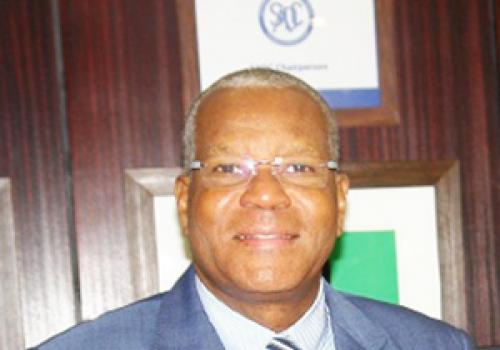The Southern African Development Community (SADC) recognises the critical role that the media plays in disseminating information and educating citizens about its activities, programmes and policies across the Region.
This was said by the SADC Executive Secretary His Excellency Mr Elias M. Magosi in his opening remarks at a webinar for SADC National Media Coordinators (NMCs) on 19th November 2021. The webinar was convened to discuss interventions to facilitate enhanced awareness, communication and visibility of SADC in Member States.
In the remarks delivered by the SADC Deputy Executive Secretary for Corporate Affairs, Ambassador Joseph Nourrice, H.E Magosi said SADC considers the National Media Coordinators as a key partner and important purveyor of information about regional integration as espoused under the Regional Indicative Strategic Development Plan 2020-2030 (RISDP 2020-2030) and the SADC Vision 2050.
He said information is power and that the responsibility of the NMCs as the custodian of SADC public information in the respective Member States is a huge responsibility as they work closely with national media in the Member States.
The NMCs play a critical role in empowering the media in the Region to accurately and objectively inform and educate the SADC citizens about its programmes, policies and activities which are aimed at improving their livelihoods, he said. The Executive Secretary called upon continued collaborative work by the NMCs and thanked them for the work done and urged them to continue on this partnership to promote the vision of the Region.
With the advent of new information and communication technologies, H.E Magosi said, information is moving at the click of a button and called upon the NMCs to devise and craft sound communication and visibility plans that will ensure that accurate information about SADC programmes and activities are disseminated timeously and to the wider audiences.
The Region has seen the sprouting of a number of websites and social media platforms which churn out information faster than the traditional media and there is therefore a need to ensure that these timeously receive accurate information about SADC so as to avoid erroneous information about the Region.
“We therefore consider your role in bridging the information gap between SADC and the media in your respective countries as of paramount importance. This is because the media has an important role to play in ensuring that SADC Regional Integration issues are publicised and spread across the Region and beyond,” said H.E Magosi.
H.E Magosi highlighted that the SADC Regional integration agenda is being championed through the RISDP 2020-2030 and the SADC Vision 2050, which are the Region’s blueprints adopted by the SADC Summit in Maputo, Mozambique, in August 2020.
An important objective for each SADC Member State is to achieve sustained economic growth and sustainable development so that people in the Region have better living standards and employment opportunities.
He said since its inception, SADC has formulated policies and strategies for Regional Integration in support of economic growth and development. The economic benefits expected from Regional Integration, as shown elsewhere around the world, include increased market size, improved intra-regional trade and investment flows, and increased transfer of technology and experience.
Through the establishment of the SADC Common Market, the overall goal of economic development and Regional Integration is to facilitate trade and financial liberalisation, to establish competitive and diversified industrial development, to increase investment, and eradicate poverty.
To achieve this goal, SADC has identified as its specific objectives, Market integration; Macro-economic convergence; Strengthening of financial and capital markets; Attainment of deeper monetary cooperation; Increasing levels of investment; and Enhancing competitiveness.
RISDP 2020-2030 and Vision 2030 represent the long-term vision that sets out the aspirations of the Region and further deepen Regional Integration. SADC envisions the removal of all barriers to deeper regional integration, guided by the objectives and principles of the SADC Treaty and Common Agenda.
In its quest to strengthen Regional Integration as enunciated through Vision 2050 and RISDP 2020-2030, SADC aspires to create a conducive environment to foster regional cooperation and integration and uphold free and fair movement of goods, people or labour, capital and services;
H.E Magosi also highlighted the aims and objectives of Vision 2050 and RISDP 2020-2030, pointing out that SADC expects the media, through support from the NMCs, to continue to inform and educate our citizens.
Both the SADC Vision 2050 and RISDP 2020-30 envision a peaceful, middle- to high-income industrialised region, where all citizens enjoy sustainable economic well-being, justice and freedom.
The vision seeks to consolidate the Community by leveraging areas of excellence and implementing policies to achieve sustainable and inclusive socio-economic development underpinned by good governance and durable peace and security in the region.
During the webinar, NMCs from Angola, Botswana, Democratic Republic of Congo, Eswatini, Lesotho, Madagascar; Malawi; Mauritius; Namibia, United Republic of Tanzania, Zambia and Zimbabwe reflected and deliberated on the level of visibility of SADC in the respective Member States, shared experiences of what has been done and what can be done to improve communication and visibility of SADC programmes and activities; how they are facilitating awareness and visibility of SADC; and what can be done at the Member States level, and at the Secretariat level to enhance communication and visibility of SADC.
(Attached photo of Ambassador Nourrice)

